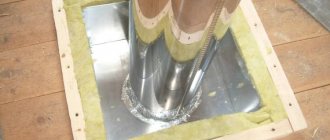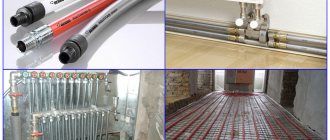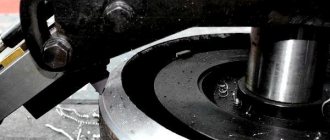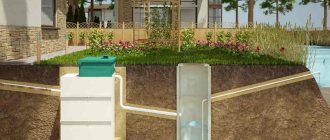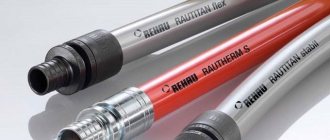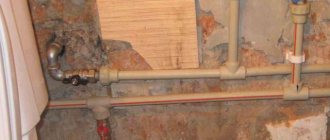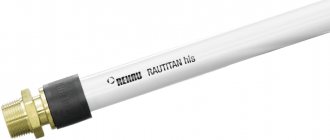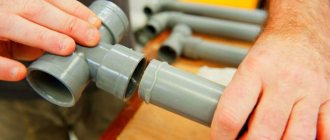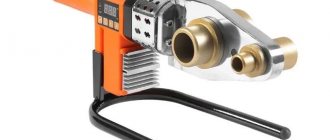What is remarkable about REHAU pipes
Modern pipe production technology gives the finished products special properties:
- Improved sound insulation. Thanks to cross-linked polyethylene, it is possible to better absorb sounds created by the movement of water in the system.
- The connection of REHAU pipes is as strong as possible due to the special method of their installation.
- The material has universal properties, thanks to which such pipes can be used to construct cold and hot water supply systems and heating circuits. Plastic can serve at water temperatures up to 95 ℃.
- Cracks do not appear on the pipes over time, they do not change their shape due to mechanical stress, which makes it possible to lay them under plaster and other structures.
- High thermal insulation qualities – saving of natural resources is possible.
- Operation of pipes is possible under conditions of changes in water temperature and pressure in the system.
- Absolute safety for the human body. This is confirmed by relevant certificates.
- The special very smooth coating of the inner walls of the pipes does not allow plaque to accumulate on them, which could thereby reduce their throughput.
REHAU pipes and all kinds of fittings are suitable for creating pipelines of varying complexity. The disadvantage of this product is its high price.
Introductory part
Long gone are the days when only cast iron and steel pipes were used during the construction of heating, sewerage and water supply systems. Then came the turn of PVC pipes, metal-plastic and ceramic pipes, as well as polypropylene. Now the technology for producing pipes from cross-linked polyethylene has appeared. The most popular manufacturer of such pipes is the German company REHAU. The pipes produced at the facilities of this corporation are called universal metal-polymer pipes REHAU made of cross-linked polyethylene. These pipes are widely used during the installation of plumbing sewerage systems, drinking water supply and internal heating. The high level of success in introducing new products is due to their excellent technical parameters.
Required tools for installation
Before connecting REHAU pipes, you need to buy a sufficient number of pipe products, fittings and adapters. The scope of all materials will become clear after drawing up a complete plumbing diagram.
The tools you will need to install REHAU pipes are:
- Expander (expander) with replaceable nozzles for pipes with different sections.
- Press clamp with replaceable attachments for different sections. Since the laying of the described pipes differs slightly from the usual welding, a specific tool for REHAU pipes will also be needed.
- A regular pipe cutter that is suitable for cutting any plastic pipes.
- Tape measure and marker for marking.
The entire list of tools can be purchased either in one set or separately.
Tool for installing push-on fittings on plastic pipes
To install water supply and heating systems made of cross-linked polyethylene with slide-on fittings, a special tool is required. These are hydraulic devices - a presser and an expander.
An expander (expander) is a device with replaceable cartridges (each cartridge corresponds to a specific type of pipe - universal, heating, thin-walled, etc.), which are equipped with opening petals. When pressure is applied, the petals open and expand the pipe to install a fitting of the same diameter into it.
The Rehau company offers two types of expanders - manual and battery-hydraulic. The cartridges for pipe expansion are the same and are suitable for all types of expanders.
The second device for installing pipes with push-in fittings is a press fitter. It is a hand-held vice that, using muscle force or hydraulics, pushes the sleeve onto a plastic pipe.
The pressing machine is a working cylinder on which two vise jaws with special U-shaped cutouts for different pipe diameters are mounted.
This tool comes in three different types - manual, mechanical-hydraulic and battery-hydraulic. Manual, by analogy with an expander, is driven by muscular force. The mechanical-hydraulic one consists of a working cylinder with a vice mounted on it, and a foot compressor that supplies working fluid through hoses into the cylinder. This type of presser is convenient because it allows installation in hard-to-reach places where it is inconvenient to straighten a hand tool.
The battery-hydraulic presser has the same advantages as the battery expander - it is autonomous and does not require the manual efforts of the installer. You can make up to 100 connections on one battery charge.
There is also a symbiosis of these two tools - a 2-in-1 battery-hydraulic tool. This device has a rotating head, on which there is an expander on one side and an expander on the other. Only one device can be in operation at a time, and they are changed by turning the head.
Installation features
When making pipe connections, even the smallest distortions are not allowed. All elements involved in the connection must be placed in the same axis, forming a clear straight line, otherwise the connection will turn out to be of very poor quality.
The laying of REHAU pipes for water and gas supply, as well as heating systems, must be carried out in accordance with all safety rules. The most important thing is to protect your eyes and hands. In the first case, you can use a protective mask, and in the second, you should refrain from touching the moving parts of any tool.
Additionally, you can clearly learn about the installation of REHAU pipes by watching the corresponding video, which shows all the nuances and the most important aspects of the work.
In conclusion, it is worth noting that the installation of pipes from the German manufacturer REHAU is quite simple, so anyone can cope with the entire list of work. The main thing is to acquire the entire list of necessary tools and fully adhere to the recommendations described above.
Installation of Rehau RAUTITAN plastic pipes with sliding fittings
Before starting work, you must prepare all the necessary tools, pipes and fittings. For the expander, the required cartridge for a given type of pipe is selected and installed, and for the vice, jaws corresponding to the diameter of the pipe are selected. For better results and ease of work, it is always recommended to use tools and materials from the same manufacturer.
Work begins by putting a sleeve on the pipe, which will subsequently slide onto the fitting. It is important to remember that the sleeve is installed exactly before the pipe is flared and joined to the fitting, otherwise it will not be possible to install the sleeve.
Next, they begin to expand the pipe with an expander. To do this, the chuck petals are inserted into the end of an evenly cut pipe until it stops and a working movement is performed (manual or automatic, depending on the tool), during which the pipe changes its shape and expands. Next, the expansion is repeated a second time, turning the pipe 30 degrees. Repeated expansion allows the pipe to be flared more evenly.
Then the fitting is inserted into the expanded end of the pipe until it stops.
The final stage is pressing in the sliding fitting. To do this, the fitting and sleeve are placed into the jaws of the pressing tool and several working movements are made until the sleeve fits tightly onto the fitting and touches its flange.
The connection is ready. A plastic pipe with a slip-on fitting is ready for use and pressure loading immediately after pressing.
The pressing process is clearly shown in the video:
Rehau pipe installation
Installation features
The products of the German company REHAU are in great demand all over the world due to their high performance characteristics, affordable price and ease of installation. Extensive experience, modern technologies and materials used in production, branded fittings and components allow the use of Rehau pipes to create water supply and heating systems for various purposes and configurations.
What are Rehau pipes
Such pipes are made from cross-linked polyethylene with various layers and additives that allow them to withstand high temperatures and pressures, protect against mechanical damage, corrosion and the ingress of oxygen, and deposits on the internal surface. The unique qualities of the material greatly facilitate installation - the pipe bends easily, and there is no need to use glue, nuts or welding to connect pipeline sections.
Their main advantages:
- produced by a world famous manufacturer;
- meet high European quality standards;
- suitable for cold water and hot water supply systems, heating systems, sewerage systems, and “warm floors”;
- due to the properties of polyethylene they have good sound and heat insulation;
- safe for health, do not promote the growth of fungi and microorganisms;
- the “shape memory” effect ensures absolutely tight connections;
- aesthetic appearance - the possibility of laying in both hidden and open ways;
- low price of pipes and their installation, real service life up to 50 years.
Types of pipes
Today the company produces a series of RAUTITAN pipes, which are used to install water supply and heating, create heated floors in an apartment, private house, cottage, country house, new buildings, shops and offices, cafes and restaurants, swimming pools, hotels, public and industrial premises. They have a wide range of applications: from connecting a heated towel rail in the bathroom to laying a heating main.
Characteristics of Rehau Rautitan products
Stabil
– a universal metal-plastic pipe consisting of a self-supporting inner layer of cross-linked polyethylene (PE-Xa), a protective layer of aluminum and an outer polyethylene layer. Operating temperature 95°C, pressure 10 bar.
Flex
– used for drinking water supply systems and low-temperature heating systems. Consists of a PE-Xa polymer layer and an oxygen-protective layer. Operating temperature 70°C, pressure 10 bar (tests carried out at 16 bar).
Pink
– pipes with the help of which only heating distribution is carried out. They consist of PE-Xa polyethylene and a special component that prevents the ingress of oxygen (which makes it unsuitable for drinking water supply systems). Operating temperature 95°C, pressure 9 bar.
His
– made of hygienic and safe polyethylene, can be used both in water supply and heating. Operating temperature 70°C, pressure 10 bar. Withstands short-term temperature increases up to 100°C.
Rautherm
– thin-walled pipes of modifications S (red) and SL (yellow), as well as thick-walled Raupink with anti-oxygen components. Red pipes are more often used for heating systems, yellow pipes are used for repair work and baseboard heating.
Rehau pipe distribution
Rehau pipe installation technology eliminates the use of various detachable elements and seals. It allows you to quickly create a reliable and tight connection even in the most difficult to reach places - in the bathroom, bathroom, toilet, kitchen. When connecting pipe sections, the cold pressing method is used.
For laying pipelines, experts recommend using a set of tools (mechanical, electro-hydraulic or battery-powered), including pipe cutters, pressing pliers, an expander with nozzles (expander), a wrench and a hand clamp.
Installation steps:
- Drawing up a wiring diagram.
- Cutting pipes to the required size.
- Selection of fittings and fasteners.
- Connection and fixation of pipes.
A sleeve and a nozzle of the appropriate diameter are put on the pipes to be connected, secured with a vice or a hand clamp. An expander is used to expand the section of pipe into which the fitting is inserted. Next, the sleeve is pushed onto it and crimped with a special press or pliers.
Rehau pipes bend easily without the use of special tools. But to prevent the bends from returning to their original straight position, the laid communications must be secured to the wall or floor with mounting brackets.
Pipe installation can be done not only by a professional plumber, but also by an experienced home craftsman with certain skills and expensive tools. To get a guaranteed high result with minimal investment of time and money when installing/replacing water supply and heating systems at any facilities in Moscow and the region, we recommend contacting the specialists of our team! With our help, all work will be performed at the highest professional level.
Usage
Rehau pipes are often used for heating systems, “warm floors,” water supply, sewer systems and “central vacuum cleaners.”
Installation of rehau pipes
It should be noted that the use of products in each area involves a different type of material and production technology.
Moreover, the company has developed a special program - RaubasicPress, which can offer two system options:
- With RE-Ha product and movable sleeve.
- With product PE-Xb.
Rehau polyethylene pipes can be used for hot or cold water supply due to the fact that their operating characteristics are no worse than metal-plastic ones. This is due to the high level of stitching performance.
As for Rehau pipes for sewerage, they can be used for internal and external systems. Installation is carried out using fittings and fittings. Therefore, the process does not take much time.
Rehau plastic products can be used for underfloor heating. Thanks to the use of cross-linked material and a minimum number of components, installation time and costs are reduced by a third.
Are they really better?
To understand whether the installation of REHAU pipes can really completely replace everyone’s favorite polypropylene and metal. It's worth starting with the material of manufacture. Cross-linked polyethylene is used for REHAU pipes. At the molecular level, a three-dimensional network is formed, which ensures the connection of all links. The end result is a bay that is uniform throughout its entire length. The advantages of this solution can be considered:
- non-toxic. The polyethylene itself in the product does not release harmful impurities into the water;
- no noise when passing water;
- versatility of the material for various systems;
- unique and simple pipe installation system “REHAU”;
- resistance to deformation and ruptures;
- high plasticity;
- minimal heat loss;
- resistance to pressure and temperature changes;
- special design and coating of the internal walls, which prevents plaque.
From the above, it becomes clear that installation of REHAU pipes is possible both in old houses and in new buildings. The products do an excellent job of transferring hot and cold liquids. This means that not only heating is easy to do using REHAU pipes, but also plumbing. Moreover, they can be laid in any configuration. REHAU pipes are easy to adjust to the line of walls and openings.
The company has developed several types of products, which allows you to quickly make a choice and determine the best price-quality ratio for a particular object. The “HIS” line is suitable for supplying any non-aggressive liquids with temperatures up to 70º. Used for heating systems with tight media control. The “REHAU Flex” subtype is also suitable for laying heating and water supply, the maximum possible pipe diameter is 63 mm. "REHAU Stabil" is able to hold its shape better, therefore it is used when installing water collection points. The peculiarity of this REHAU pipe is explained by the small layer of aluminum. The pink series “REHAU Pink” is used exclusively for heated floors or general wiring of the heating system. They are very plastic and require fixation with fasteners. They feel great under screed and plaster. Withstands temperatures up to 90º and pressure up to 10 atmospheres.
Installation
The installation is similar to the installation of any pipes, however, there are certain nuances:
- There are special Rehau tools for installation.
This tool is needed to simplify the process. Rehau special tools for installation - Installation of products is carried out using threaded or welded connections, as well as shaped products and fittings.
- There is a company development - a connection with a movable sleeve. It can be covered with plaster.
If you choose heating pipes from the Rehau company, then installation will be simplified, and the pipeline will serve reliably and for a long time. And if you still have open questions about the installation nuances, you can additionally watch the video. This will avoid mistakes.
What are the dangers of installation errors?
If the installation of Rehau pipes in an apartment or house is carried out incorrectly, without the use of special equipment and knowledge, the result of such work can be sad. is guaranteed to follow , followed by flooding of the premises .
If a heating system rupture occurs in winter, the system is in danger of completely freezing, which makes its restoration a very expensive undertaking.
To avoid problems, it is better to let professionals handle such work. The craftsmen will ensure competent drawing up of pipe laying schemes, creation of a high-quality system with even seams, and the correct selection of pipes and connectors.
Stages of plumbing assembly
First, a design drawing is prepared and cutting is carried out according to measurements. All elements are laid out according to the diagram, the joints are completed. The process of joining pipes with compression fittings occurs as follows:
- The pipe is cut using scissors or a regular saw at a right angle.
- A movable sleeve is placed on the pipe, and the chamfer is directed towards the connection.
- The end of the pipe is expanded with an expander and the sleeve is pressed onto the fitting.
- The joint is grabbed with press jaws, trying to align the tool without distortion.
- The special lever on the press is moved into the press-fit, the handle of the expander is brought together and the sleeve is pushed towards the flange itself.
When performing R ehau pipes, even the slightest distortion should not be allowed. All elements should be placed on the same axis, creating a clear line.
The laying of the pipeline of any system, be it gas, water, heating, must be carried out in accordance with safety requirements .
